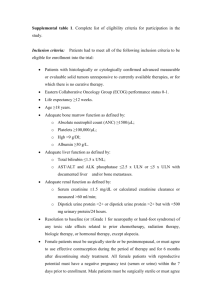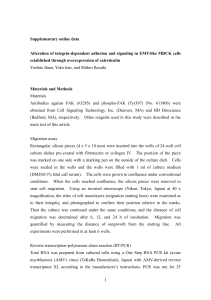Harvard-MIT Division of Health Sciences and Technology
advertisement
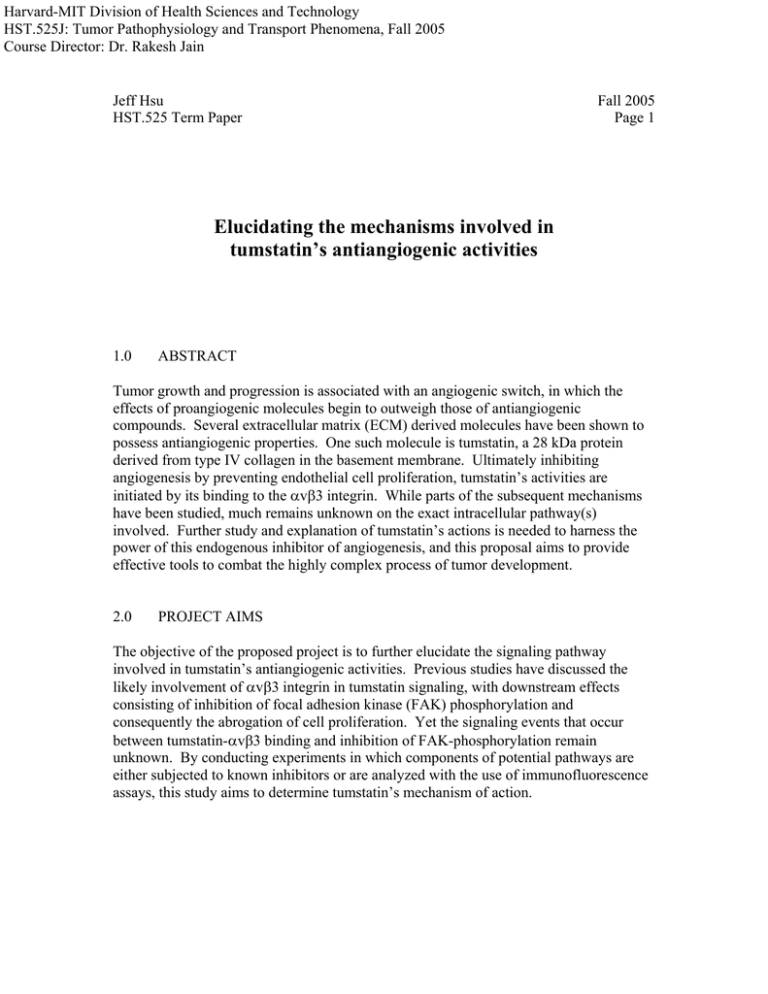
Harvard-MIT Division of Health Sciences and Technology HST.525J: Tumor Pathophysiology and Transport Phenomena, Fall 2005 Course Director: Dr. Rakesh Jain Jeff Hsu HST.525 Term Paper Fall 2005 Page 1 Elucidating the mechanisms involved in tumstatin’s antiangiogenic activities 1.0 ABSTRACT Tumor growth and progression is associated with an angiogenic switch, in which the effects of proangiogenic molecules begin to outweigh those of antiangiogenic compounds. Several extracellular matrix (ECM) derived molecules have been shown to possess antiangiogenic properties. One such molecule is tumstatin, a 28 kDa protein derived from type IV collagen in the basement membrane. Ultimately inhibiting angiogenesis by preventing endothelial cell proliferation, tumstatin’s activities are initiated by its binding to the αvβ3 integrin. While parts of the subsequent mechanisms have been studied, much remains unknown on the exact intracellular pathway(s) involved. Further study and explanation of tumstatin’s actions is needed to harness the power of this endogenous inhibitor of angiogenesis, and this proposal aims to provide effective tools to combat the highly complex process of tumor development. 2.0 PROJECT AIMS The objective of the proposed project is to further elucidate the signaling pathway involved in tumstatin’s antiangiogenic activities. Previous studies have discussed the likely involvement of αvβ3 integrin in tumstatin signaling, with downstream effects consisting of inhibition of focal adhesion kinase (FAK) phosphorylation and consequently the abrogation of cell proliferation. Yet the signaling events that occur between tumstatin-αvβ3 binding and inhibition of FAK-phosphorylation remain unknown. By conducting experiments in which components of potential pathways are either subjected to known inhibitors or are analyzed with the use of immunofluorescence assays, this study aims to determine tumstatin’s mechanism of action. Jeff Hsu HST.525 Term Paper 3.0 Fall 2005 Page 2 BACKGROUND & SIGNIFICANCE The essential role of angiogenesis in the development of solid tumors has been studied extensively over the past few decades, beginning with Dr. Judah Folkman’s work in the early 1970s (Folkman 1972). Human cells, including most tumor cells, need to be supplied with oxygen in order to survive. Due to the limited diffusivity of oxygen, this aerobic requirement prevents tumor growth beyond 1-2 mm3 unless a vascular network is recruited via angiogenesis (Folkman 2003). Thus, while angiogenesis is a normal physiologic process in events such as healing and wound repair, its actions contribute to the pathology of tumor development. Recently, more work has been done to shed light on endogenous inhibitors of angiogenesis, which normally function to balance angiogenesis. In tumor environments, however, this balance is altered such that angiogenesis is heavily favored. Yet with angiogenesis inhibitors naturally present in cellular microenvironments, there exists great potential to utilize this endogenous resource to combat the growth of tumors. 3.1 The role of the vascular basement membrane and extracellular matrix in tumor development Among the approximately 50 proteins that constitute the vascular basement membrane (VBM) – an amorphous structure similar to the extracellular matrix (ECM) found in all tissues – are collagen and laminin. These components play important roles in the regulation of tumor development. For instance, angiogenesis requires the migration of endothelial cells to form the new vascular network. For such an event to occur, the complex structure formed by type IV collagen and laminin, among other proteins, must break down to allow for endothelial cell movement. In this process, various domains of the VBM proteins are exposed to endothelial cells, potentially stimulating the continuation of angiogenesis. Additionally, during the VBM degradation process, previously sequestered growth factors such as VEGF, PDGF, and FGF are released, promoting angiogenesis. However, normal physiologic conditions present a balance of both pro- and antiangiogenic molecules. As mentioned above, components of the VBM can stimulate the progression of angiogenesis. Yet interestingly enough, these same components can also possess antiangiogenic characteristics. Many endogenous inhibitors of angiogenesis have been discovered to be cleaved fragments of collagen, and an example of one such molecule is endostatin. Derived from the NC1 domain of the α1 chain of type XVIII collagen, its antiangiogenic properties have been shown to result from its ability to inhibit endothelial cell migration (Sudhakar 2003). Other VBM-derived inhibitors of angiogenesis include arresten, canstatin, vastatin, and restin. The antiangiogenic capabilities of such molecules result from the exposure of cryptic sites on collagen, which are sites that are normally hidden within the folded and assembled structure of collagen. Degradation and/or cleavage of these collagen networks allow for the exposure of these cryptic sites and, consequently, the expression of their antiangiogenic activities. Jeff Hsu HST.525 Term Paper 3.2 Fall 2005 Page 3 Tumstatin: current knowledge Another VBM-derived molecule shown to have antiangiogenic properties is tumstatin. A 28-kDa fragment derived from the NC1 domain of the α3 chain of type IV collagen (Maeshima 2000), tumstatin is likely produced by cleavage of type IV collagen by a matrix metalloproteinase (MMP), and work by Hamano et al has led to speculation that MMP-9 specifically is involved in tumstatin production through type IV collagen cleavage (Hamano 2003). Research by Sudhakar et al has shed light on how tumstatin inhibits angiogenesis by abrogating processes essential to cell proliferation (Sudhakar 2003). Tumstatin binds to αvβ3 integrin in an RGD-independent manner (Maeshima 2000). This integrin is normally expressed in very small amounts on the surfaces of latent endothelial cells, but is upregulated on the surfaces of activated endothelial cells. Such a feature points to αvβ3 integrin’s role in promoting angiogenesis, allowing migrating endothelial cells to bind to RGD domains on proximal ECM-ligands (e.g. vitronectin and fibronectin) and thereby stabilizing the formation of new vessels (Brooks 1994). Yet debate exists on whether the integrin is in fact proangiogenic or antiangiogenic, as evidence exists that support both hypotheses (Hynes 2002). Focusing on tumstain’s interaction with αvβ3, however, Sudhakar et al have shown that downstream of this interaction, the phosphorylation of focal adhesion kinase (FAK) is inhibited. Normally, phosphorylated-FAK (FAK-P) activates PI3-kinase (PI3-K), which signals the mTOR pathway. This pathway is responsible for cap-dependent translation of proteins from mRNA. By preventing this protein synthesis, tumstatin ultimately stops the cell from proliferating, and a schematic of tumstatin’s mechanism of action is shown in Figure 1 below. As seen in Figure 1, a “black box” of unknown mechanisms exists between the tumstatinαvβ3 integrin interaction and the inhibition of FAK phosphorylation. The purpose of this proposal is to elucidate the events that occur within this “black box,” enabling us to more effectively understand tumstatin’s mechanism of antiangiogenic action(s). Recent in vivo research utilizing mouse models demonstrate tumstatin’s role in regulating tumor growth. Sund et al have shown that mice deficient in both tumstatin and thrombospondin-1 (TSP-1, an ECM-derived inhibitor of angiogenesis) displayed tumor growth that was twice as fast as the growth observed in either tumstatin or TSP-1 knockout mice (Sund 2005). Additionally, Kalluri has found that the overexpression of tumstatin in mice leads to a decreased rate of tumor growth (Kalluri, unpublished). Such results reiterate the idea that tumor growth is not regulated solely by the tumor cells themselves, but also by the environment that surrounds them. Jeff Hsu HST.525 Term Paper Fall 2005 Page 4 Figure 1: Current understanding of a possible mechanism of action of tumstatin. Tumstatin interacts with αvβ3 integrin, which results in the downstream inhibition of the phosphorylation of focal adhesion kinase (FAK). FAK-P is responsible for activating the mTOR pathway through PI3-kinase (PI3-K), which allows for cap dependent protein translation from mRNA. Tumstatin’s activity thus inhibits protein synthesis and consequently prevents cell proliferation. The black box between the αvβ3 integrin and the FAK-phosphorylation event consists of currently unknown mechanisms, and this proposal aims to shed light on the events that take place here. (Adapted from Sudhakar 2003) 3.3 Clinical potential of endogenous angiogenesis inhibitors The significance of inhibitors such as tumstatin lies in their target: the endothelial cell. As described above, tumstatin prevents angiogenesis by inhibiting the proliferation of endothelial cells. Such a treatment is advantageous in that endothelial cells are less likely to develop resistance to treatments than tumor cells are (due to the unstable genetic nature of tumor cells). Additionally, the utilization of endogenous inhibitors offers the advantage of small but continuous doses, as well as actions through multiple pathways (Tandle 2004). Thus the discovery of an effective way to use these inhibitors in cancer treatment would be of immense value. Jeff Hsu HST.525 Term Paper Fall 2005 Page 5 Earlier this decade, the results of 3 phase I clinical trials that tested the therapeutic efficacy of recombinant human endostatin were published (Eder 2002, Herbst 2002, Thomas 2003). These results were not what was hoped for – the trials’ patients showed little response, if any, to the administered endostatin. 3.4 Importance of determining mechanisms of action Although the failure of these trials left many disappointed, Clamp and Jayson discuss the need for continued research on endogenous inhibitors of angiogenesis in spite of endostatin’s apparent lack of effectiveness (Clamp 2005). They stress the importance of understanding the mechanisms of action of inhibitors like endostatin, so that parameters such as biologically effective dose (BED) and the best way to deliver such doses can be discovered. A deeper understanding of a molecule’s mechanism of action can ultimately lead to better clinical trial designs and patient selection. As we plan to expose tumstatin’s mechanism of action in this proposed study, there exists great potential to find an effective way to use endogenous agents to inhibit pathological angiogenesis and ultimately turn the angiogenic switch ‘off’ in cancer patients. Further knowledge of these mechanisms will enable us to determine which molecules act through which pathways, and consequently, which endogenous inhibitors can be combined (endostatin and tumstatin, for instance) to provide an effective treatment against tumor growth and development. Jeff Hsu HST.525 Term Paper 4.0 METHODS 4.1 Cell lines and culture Fall 2005 Page 6 Human umbilical vein endothelial cells (HUVECs) will be obtained from American Type Culture Collection (ATCC). The cells will be maintained in EGM-2 media (clonetics, San Diego, CA) at 37°C in a humidified 5% CO2 atmosphere. Passages 3-5 will be used for all experiments. 4.2 Production of recombinant human tumstatin (rhTum) Using polymerase chain reaction (PCR) from the α3(IV)NC1/pDS vector (as described in Neilson 1993), the sequence encoding tumstatin will be amplified. After ligating the resulting cDNA fragment into pET22b(+) or pET28a(+) (Novagen, Madison, WI), the recombinant protein will be expressed in Escherichia coli cells. The protein will then be purified using a nickel-nitrilotriacetic acid-agarose column (Qiagen). 5.0 RESEARCH DESIGN The following section aims to discover the events involved in the interaction between tumstatin-activated αvβ3 integrin and FAK. FAK is known to interact directly with cytoplasmic domains of integrins, including the β3 cytoplasmic tail (Akiyama 1994). Yet this does not necessarily mean that this is the pertinent interaction in tumstatin’s mechanism of action. For instance, one of many potential scenarios is that tumstatin’s activation of αvβ3 integrin can result in the recruitment of a protein that quickly dephosphorylates FAK. In any case, what is currently known is that tumstatin’s binding to αvβ3 integrin inhibits the phosphorylation (or sustained phosphorylation) of FAK. These methods will analyze several possible mechanisms, including inhibition of FAK-integrin binding and recruitment of inhibitory proteins. SPECIFIC AIM 1: Tumstatin has been shown to inhibit the phosphorylation of FAK (Sudhakar 2003). We hypothesize that tumstatin achieves this inhibition by inducing a conformational change in the αvβ3 integrin upon binding to it, preventing FAK from binding to the β3 cytoplasmic tail. Without binding to this segment of the integrin, FAK cannot carry out autophosphorylation, leaving the protein unphosphorylated and thereby inactivated. Jeff Hsu HST.525 Term Paper Experiment: Fall 2005 Page 7 Immunofluorescent investigation of FAK-αvβ3 interactions upon tumstatin binding The following experiment aims to determine whether tumstatin inhibits FAK localization to the αvβ3 integrin in endothelial cells. For the immunofluorescence colocalization experiment, 106 HUVECs will be seeded into 10-cm2 dishes coated with fibronectin or vitronectin. To coat the dishes, 10 ug/ml solutions of each ECM-ligand will be allowed to incubate on the phosphate buffered saline (PBS)-rinsed dishes for approximately 12 hrs at 37°C. Before seeding, some cells will be preincubated with rhTum, while others are left untreated. Additionally, a different group of cells will be incubated with rhTum postseeding, in order to determine whether or not temporal elements are an issue in tumstatin’s actions. After the seeded HUVECs have been incubated with rhTum for a sufficient amount of time (approximately 4-6 hrs), the cells will be fixed with 4% formaldehyde in PBS for 6 min at room temperature, then rinsed with PBS briefly twice. The cells will then be permeabilized by exposing them to 0.2% Triton X-100 in PBS for 6 mins. Once permeabilized, two different antibodies will be added: one specific for FAK (potentially, affinity-purified rabbit anti-FAK), and one specific for αvβ3 integrin (potentially, affinity-purified mouse anti-αvβ3). Each antibody should not bind to a region that is involved in the normal interaction between the integrin and FAK, to prevent the experimental design from interfering from normal cellular processes. After washing the cells, two fluorescent antibodies will be added: rhodamine-labeled goat anti-mouse IgG, and fluorescein-labeled donkey anti-rabbit IgG (similar to immunofluorescence procuedure described in Kornberg 1992). To rule out cross-reaction between the two secondary antibodies, control experiments will be performed in which one of the primary antibodies will be omitted. The stained cells will be viewed under a fluorescent microscope, and the colocalization, or lack of, of fluorescent markers for each condition will be analyzed. If colocalization of FAK and αvβ3 integrin is seen in the absence of tumstatin, but not observed in tumstatin’s presence, then the data will point to tumstatin’s inhibition of FAK-integrin binding. This inhibition will have likely occurred through an induced conformational change of the integrin. Figure 2 below presents a schematic of the potential mechanism examined by this experiment. Jeff Hsu HST.525 Term Paper Fall 2005 Page 8 Figure 2: Potential mechanism of tumstatin action examined by proposed immunofluorescence experiment. If FAK is still found to colocalize with the integrin, then the results will have allowed us to rule out the inhibition of FAK-integrin binding from tumstatin’s mechanism of action. SPECIFIC AIM 2: While one mechanism of tumstatin’s inhibitory actions may be the induced conformational change investigated in “Specific Aim 1,” another pathway may involve the upregulation and/or increased activity of phosphatases that dephosphorylate FAK. We therefore hypothesize that tumstatin’s binding to αvβ3 integrin has a positive regulatory effect on FAK phosphatase activity. Currently, the phosphatases known to dephosphorylate FAK are PTP-1D (also known as SHP-2 or Syp) and FRNK. As these are the only FAK-dephosphorylating proteins we have found in our review of the existing literature, the activities of these proteins will be investigated in this experiment. Experiment: Analyzing the potential tumstatin-induced dephosphorylation of FAK PTP-1D Ouwens et al have shown that insulin can induce tyrosine dephosphorylation of FAK through active phosphotyrosine phosphatase 1D (PTP-1D) (Ouwens 1996). Since insulin’s effects are mediated by its binding to a membrane protein and the subsequent signaling, it is possible that PTP-1D can be activated by tumstatin binding to αvβ3 integrin. To examine this possibility, untreated and rhTum-treated HUVECs (seeded and treated in the manner described above) will be lysed in RIPA-DOC buffer. The cell lysates will then be washed with cold PBS and incubated for 4 hrs with polyclonal affinity-purified Jeff Hsu HST.525 Term Paper Fall 2005 Page 9 anti-phosphotyrosine antibodies. PTP 1D and anti-phosphotyrosine immune complexes will be collected on Protein A-Sepharose beads, and the collected complexes will be washed four times with lysis buffer and twice with 10mM Tris/HCl (ph 7.5), ImM EDTA. The complexes will then be dissolved in SDS-PAGE sample buffer (10% glycerol, 5% β-mercaptoethanol, 3% SDS, 0.1 M Tris/phosphate, ph 6.8, and 0.01% Bromphenol Blue), and subsequently resolved by SDS-PAGE. After SDS-PAGE, the proteins will be transferred to Immobilon membranes (Millipore, Bedford, MA) by Western blotting. The filters will be incubated with antiphosphotyrosine antibody PY20 conjugated to horseradish peroxidase. The bound horseradish peroxidase will then be visualized by enhanced chemiluminescence. (Protocol adapted from Ouwens 1996.) If this experiment shows an increased presence of active PTP-1D in the rhTum-treated cells, the data might suggest that tumstatin binding to αvβ3 integrin results in upregulation of active PTP-1D, which may play a role in the inhibition of FAK phosphorylation observed by Sudhakar et al. Further investigation of PTP-1D’s potential role in tumstatin’s mechanism of action can also be done by pretreating the cells with phenylarsine oxide (PAO); Guvakova and Surmacz have shown that PAO restores FAK activity by inhibiting PTPs (Guvakova 1999). If HUVECs treated with tumstatin and PAO maintain their proliferative abilities, then PTP-1D is likely involved in the pathway. FRNK Another potential endogenous inhibitor of FAK activation is FAK-related nonkinase (FRNK). Expressed in smooth muscle cells, FRNK has been shown to attenuate FAK activity (Taylor 2001), and tumstatin’s binding to the integrin may result in FRNK upregulation. Methods similar to the ones described above for the PTP-1D assay will be used to analyze tumstatin’s effect on FRNK activity, but an anti-FRNK antibody will be used instead of an antiphosphotyrosine antibody. Controls For these experiments, appropriate controls might include the addition of antibodies to molecules that should be present in the experiment (positive control). Such a positive control could include the addition of an antibody for FAK itself. For a negative control, we will choose to refrain from adding antibodies to the experiment. The corresponding lane on the Western Blot should therefore show no band. Jeff Hsu HST.525 Term Paper Fall 2005 Page 10 SPECIFIC AIM 3 Tumstatin is known to bind preferentially to the αvβ3 integrin, yet the exact tumstatinbinding region on the integrin remains unknown. The following experiment aims to determine which extracellular region of αvβ3 integrin binds to tumstatin. Experiment: Examining tumstatin binding to αvβ3 integrin Maeshima et al have shown that the antiangiogenic activity of tumstatin lies in its 54-132 amino acid region (Maeshima 2000). Additionally, they show that tumstatin binds to αvβ3 integrin in an RGD-independent manner. Nevertheless, while it is known that tumstatin does not bind to the same region on αvβ3 integrin that RGD-ligands bind to, it remains unclear as to which region on the extracellular domain of the integrin is involved in binding. Further understanding of tumstatin-integrin binding can lead to deeper insight into possible conformational changes that result in the integrin, which can lead to various intracellular signaling events that may cause the inhibition of FAK phosphorylation. With knowledge of the 54-132 aa sequence of tumstatin, as well as the extracellular domain sequence of αvβ3 integrin, the computer simulations can be performed to assess which regions on the integrin are most likely to bind tumstatin. These simulations would include the use of a program called Chemistry at Harvard Molecular Mechanics, or CHARMM (Harvard University, Cambridge, MA), to solve the molecular dynamics of the tumstatin and the integrin. After obtaining these solutions, the dynamics will be visualized using a program called Visual Molecular Dynamics, or VMD (University of Illinois, Urbana-Champagne). Lastly, using MATLAB software (The Mathworks, Natick, MA), the trajectories of the dynamics will be analyzed. With customized coding, we will be able to record which regions of both molecules spend a large portion of the simulation time within a specified distance of each other. These high-affinity regions are likely to be the binding regions between tumstatin and αvβ3 integrin. Once these highly probable regions are identified, additional simulations can be performed which can show potential conformational changes in the integrin that result from tumstatin binding. Such information can lend further insight into hypotheses such as the one tested by the immunofluorescence experiment described earlier. Jeff Hsu HST.525 Term Paper 6.0 Fall 2005 Page 11 ACKNOWLEDGMENTS We would like to thank Dr. Raghu Kalluri for taking the time to answer questions about the currently known mechanisms of tumstatin’s actions, and also for pointing us to past research that could help us in our experimental design. Additionally, we thank Dr. Rakesh Jain and (soon-to-be-Dr.) Wilson Mok for their guidance throughout the semester. 7.0 REFERENCES Akiyama SK, Yamada SS, Yamada KM and LaFlamme SE. “Transmembrane signal transduction by integrin cytoplasmic domains expressed in single-subunit chimeras.” J Biol Chem 269: 1596115964, 1994. Brooks PC, Clark RA, Cheresh DA. “Requirement of vascular integrin alpha v beta 3 for angiogenesis.” Science 264:569-571, 1994. Clamp AR, Jayson RC. "The clinical potential of antiangiogenic fragments of extracellular matrix proteins." British Journal of Cancer. 2005. Eder JP, Supko JG, Clark JW, Puchalski TA, Garcia-Carbonero R, Ryan DP, Shulman LN, Proper J, Kirvan M, Rattner B, Connors S, Keogan MT, Janicek MJ, Fogler WE, Schnipper L, Kinchla N, Sidor C, Philips E, Folkman J, Kufe DW. “Phase I clinical trial of recombinant human endostatin administered as a short intravenous infusion repeated daily.” J Clin Oncol 20: 3772-3784. Folkman J. Ann Surg, 175, 409-416. 1972. Folkman J, Kalluri R. “Tumor angiogenesis.” In: Kufe DW, Pollock RE, Weichselbaurm RR, Bast RC Jr., Gansler TS, Holland JF, Frei E III, editors. Cancer Medicine 6. Bc Delger Inc. Hamilton, Canada 2003:161-94. Guvakova MA, Surmacz E. “The activated insulin-like growth factor I receptor induces depolarization in breast epithelial cells characterized by actin filament disassembly and tyrosine dephosphorylation of FAK, Cas , and paxillin.” Experimental Cell Research, 251: 1, 244-255, 1999. Hamano T, Hamano Y, Zeisberg M, Sugimoto H, Lively JC, Maeshima Y, Yang C, Hynes RO, Werb Z, Sudhakar A, Kalluri R. “Physiological levels of tumstatin, a fragment of collagen IV alpha3 chain, are generated by MMP-9 proteolysis and suppress angiogenesis via alphaV beta3 integrin.” Cancer Cell 2003;3:589-601. Herbst RS, Hess KR, Tran HT, Tseng JE, Mullani NA, Charnsangavej C, Madden T, Davis DW, McConkey DJ, O’Reilly MS, Ellis LM, PLuda J, Hong WK, Abbruzzese JL. “Phase I study of recombinant human endostatin in patients with advanced solid tumors.” J Clin Oncol 20:37923803, 2002. Hynes, RO. “A reevaluation of integrins as regulators of angiogenesis.” Nature Med, 8:9, 918-921, 2002. Kalluri R. “Basement Membranes: Structure, Assembly and Role in Tumour Angiogenesis.” Nature Reviews Cancer, 2003. Kalluri R. "Tumstatin, the NC1 domain of a3 chain of type IV collagen, is an endogenous inhibitor of pathological angiogenesis and suppresses tumor growth." Biochemical and Biophysical Research Comm. 2005. Kornberg L, Earp HS, Parsons JT, Schaller M, Juliano RL. “Cell adhesion or integrin clustering increases phosphorylation of a focal adhesion-associated tyrosine kinase.” J Biol Chem, 267:33, 2343923442, 1992. Neilson EG, Kalluri, R, Sun MJ, Gunwar S, Danoff T, Mariyama M, Myers JC, Reeders ST, Hudson BG. J Biol Chem, 288, 8402-8405, 1993. Ouwens DM, Mikkers HM, van der Zon GC, Stein-Gerlach M, Ullrich A and Maassen JA. “Insulininduced tyrosine dephosphorylation of paxillin and focal adhesion kinase requires active phosphotyrosine phosphatase 1D.” Biochem J 318: 609-614, 1996. Sund M, Xie L, Kalluri R. “The contribution of vascular basement membranes and extracellular matrix to the mechanics of tumor angiogenesis.” APMIS, 2004. Sund M, et al. “Function of endogenous inhibitors of angiogenesis as endothelium-specific tumor suppressors.” PNAS, 2005. Jeff Hsu HST.525 Term Paper Fall 2005 Page 12 Tandle A, Blazer DG, Libutti SK. “Antiangiogenic gene therapy of cancer: recent developments.” Journal of Translational Medicine, 2004. Taylor JM, Mack CP, Nolan K, Regan CP, Owens GK, Parsons JT. “Selective expression of endogenous inhibotr of fAK regulates proliferation and migration of vascular smooth muscle cells.” J Mol Cell Biol, 21:5, 1565-1572, 2001. Thomas JP, Arzoomanian RZ, Alberti D, MArnocha R, Lee F, Friedl A, Tutsch K, Dresen A, Geiger P, Pluda J, Fogler W, Schiller JH, Wilding G. “Phase I pharmacokinetic and pharmacodynamic study of recombinant human endostatin in patients with advanced solid tumors.” J Clin Oncol 21: 223-231, 2003.
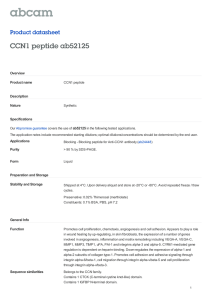
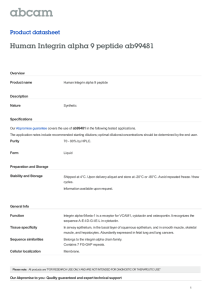
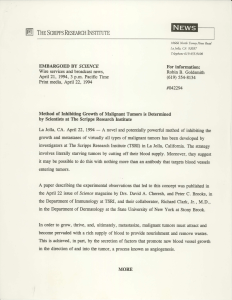
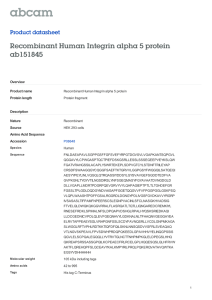
![Anti-Integrin alpha 9+beta 1 antibody [Y9A2] ab27947](http://s2.studylib.net/store/data/012730297_1-98df58bbcdfaeae2c8d6615dfb776888-300x300.png)
